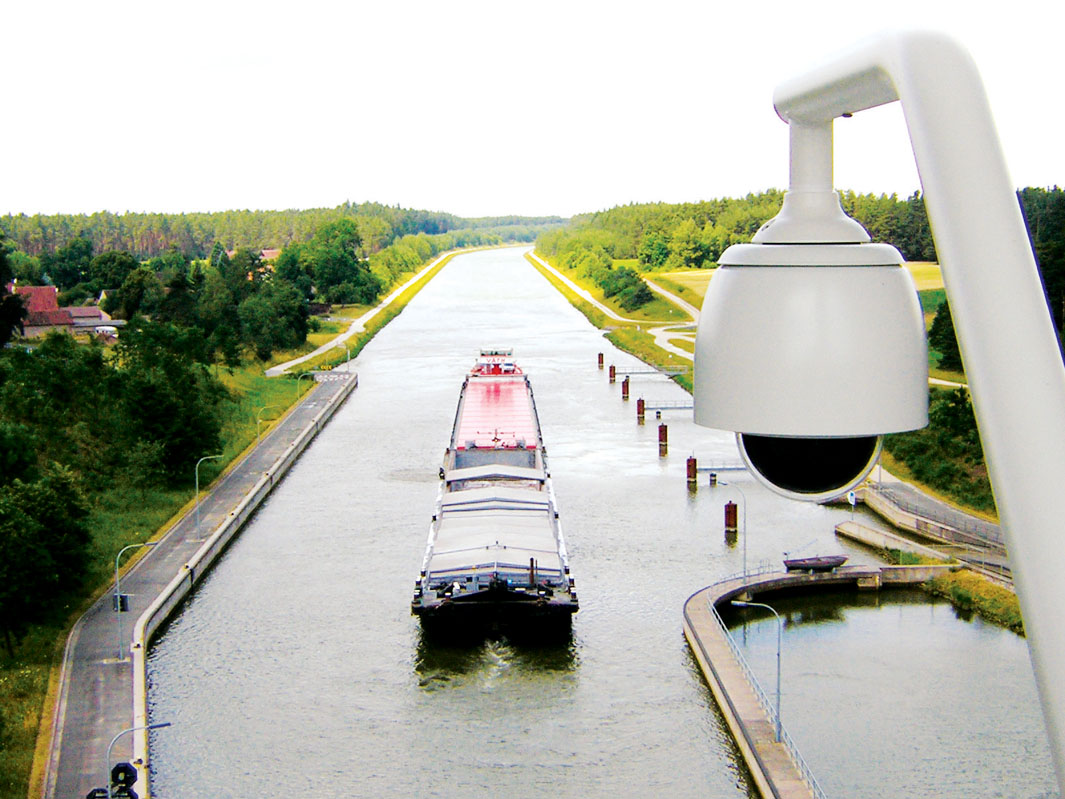
A Bosch AutoDome camera mounted at the downstream end of the Bachhausen lock on the Rhein-Main-Donau (RMD) canal near Nuremberg in Germany. The RMD canal opened in 1992, is 171 kilometers long and has 16 locks. Its link with the Rhine, Main and Danube rivers connects the seaports of Rotterdam and Antwerp with the Black Sea, a distance of 3,500km. (Photo by Bosch Security Systems)
|
Some Canal Facts & Figures
|
-
The worlds longest and oldest canal is the China Grand Canal, between Beijing and Hangzhou. Started in 486 B.C. and completed in the 13th century, it is now 1,795km in length, and has 24 locks.
-
The USA has 40,000km of inland waterways, one of the largest being the Mississippi River System, which has 29 locks, typically 180m in length.
-
The Great Lakes-Saint Lawrence Seaway System is the worlds longest deep-draft inland waterway, extending from the Atlantic Ocean to Lake Superior -- a distance of more than 3,700km.
-
A new inland waterway system, linked to the river Thames, will be developed for transporting supplies and spoil by barge to and from the construction site of the 2012 London Olympics.
-
The UK currently has more than 100 canal systems, mostly for pleasure craft. It was recently reported that British Waterways plans to increase canal commercial traffic by a factor of 4 to 6 million tons by 2010.
-
The worlds largest canal lock is the Berendrecht lock in Antwerp, which is 500m in length and 68m wide, and enables vessels of up to 130,000 tons to reach the harbour 70km inland from the sea. |
Rivers and man-made waterways canals have been used for centuries for inland transport of goods and bulk materials, as well as for pleasure. As such, they are the water equivalent of roadways, but the key difference is that the ¡®traffic¡¯ comprises ships, barges and boats instead of cars, trucks and motorcycles. So, for the same reasons that CCTV surveillance is used on land roadways, it is also of great value in monitoring and controlling traffic on rivers and canals. This article discusses the increased use of rivers and canals for commerce and pleasure; the various criteria that determine the configurations and positioning of CCTV systems on inland waterways; and typical solutions.
FALL & RISE OF WATERWAY USE
The use of inland waterways for commercial purposes reached a peak in Europe during the industrial revolution in the late 18th and early 19th centuries. But, as railways and, later, roads, began to improve, they became more economical than canals and rivers for transport. However, in the mid 20th century canals became popular again, mostly for holiday makers, and a number of countries, notably the U.K., France, Germany, Belgium and the Netherlands, re-opened or renovated many of their canals. At the same time, some of these countries, particularly the Netherlands and Germany, increased the volume of commercial traffic, mainly with large, powerful state-of-the art barges that can carry dry or liquid cargoes up to 3,000 tons. Another reason for the increased use is to reduce road haulage traffic and associated pollution.
CRITERIA FOR SURVEILLANCE
The key criteria that determine size and configuration of CCTV systems for inland waterways are based on:
-
Width and depth - decides traffic capacity and frequency;
-
Whether for commercial or pleasure traffic or both;
-
Number, type, size and capacity of locks;
-
Whether locks are manned or unmanned;
-
Whether locks are manually or hydraulically/electrically operated;
-
Whether surveillance is needed at bridges, tunnels or junctions.
|
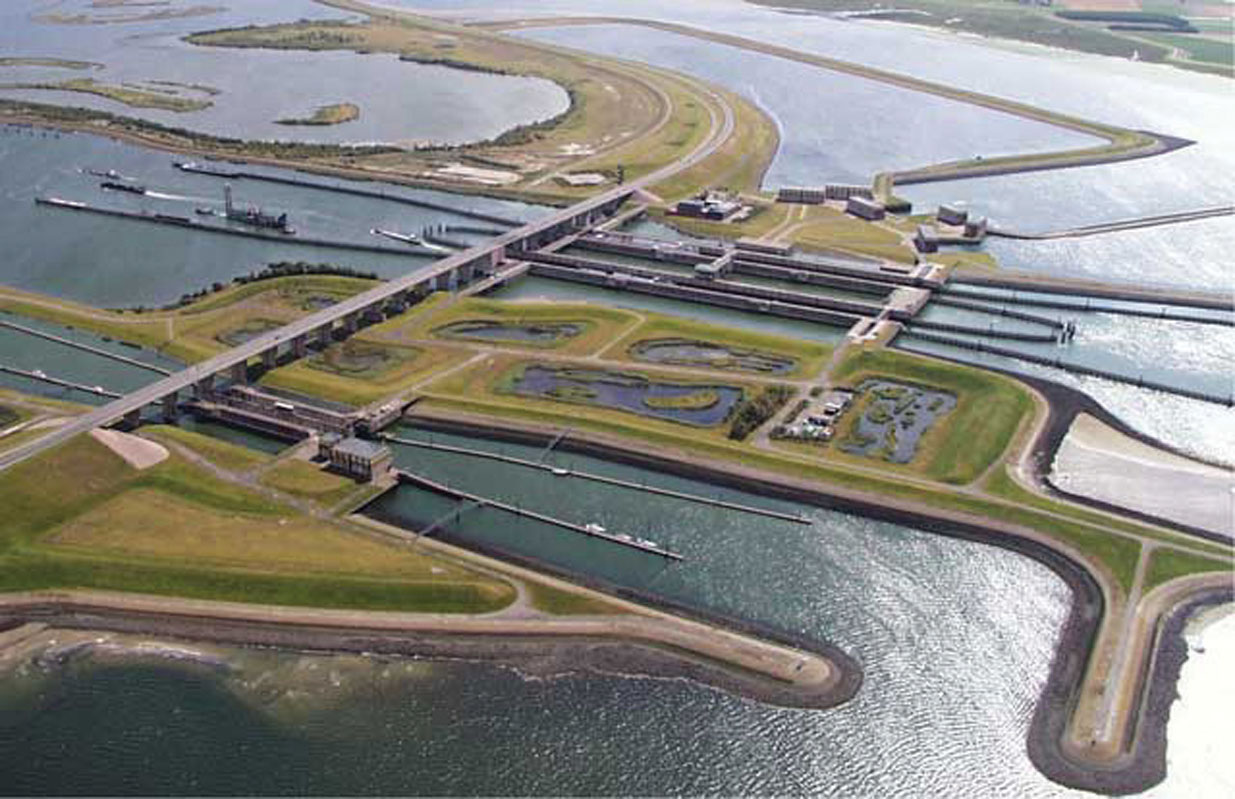
|
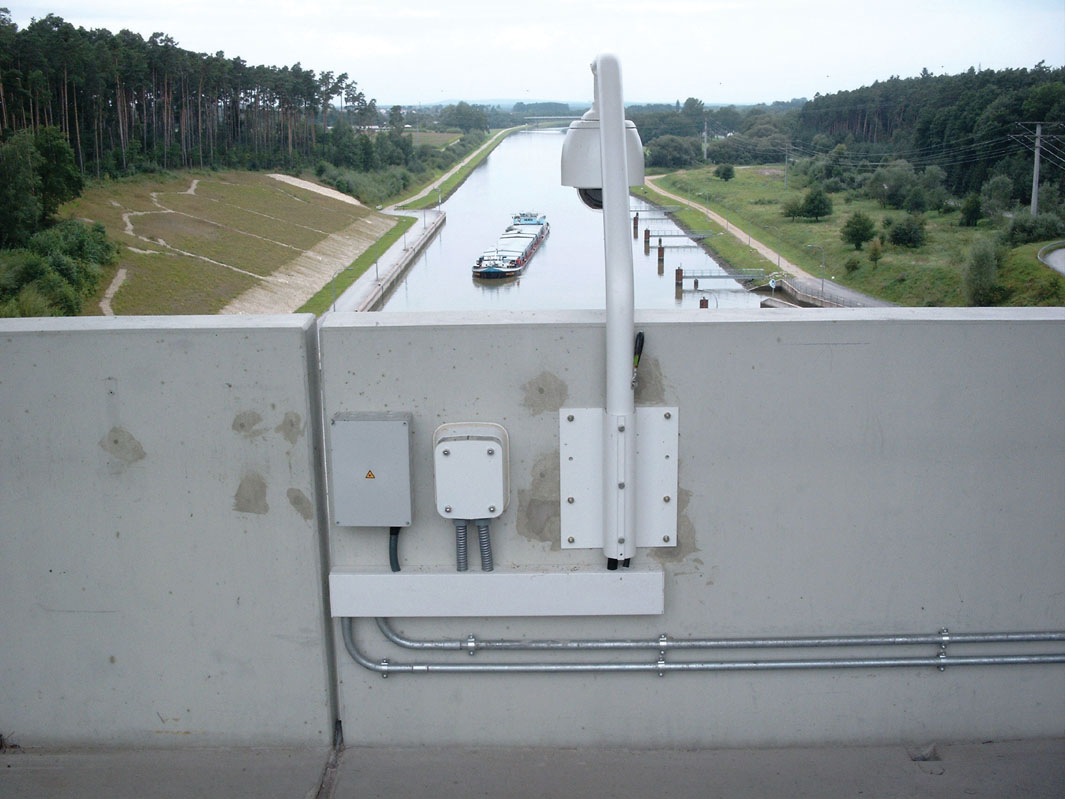
|
|
Photo by Bosch Security Systems |
|
UPSTREAM/ DOWNSTREAM
The first three criteria also determine how far upstream and downstream from a lock cameras need to be located. If the traffic frequency is high and/or there is a high number of larger vessels and/or a lock size is relatively small, cameras would need to be placed at a greater distance from a lock than if these factors were otherwise. In other words, a situation with the above factors would mean that vessels could be queued for some distance from a lock, possibly a number of kilometers. Camera surveillance allows the person controlling the locks -- the lockmaster -- to know how many vessels are queued and the upstream or downstream distance. The type of camera used here would normally be fixed.
The best fixed camera solution offered by Bosch is the DinionXF day/night camera. The key feature of the DinionXF camera is known as XF-Dynamic, which is enabled by 15-bit DSP technology and advanced CCD chipsets to produce an exceptionally high number of grey levels. This results in wide dynamic range and high-quality image reproduction of details in high- and low-lit scenes. Connecting the upstream and downstream cameras to the central control room is best achieved using optical fiber cabling that enables maximum picture quality with no signal loss due to distance. An alternative could be wireless connection, but optical fiber is better for the reason stated. Moreover, installing optical fiber cabling is easier and less costly than alongside a roadway, mainly because canals have long, straight stretches with unencumbered banks.
LOCK SURVEILLANCE
Surveillance at a lock is necessary to ensure that the gates can be closed or opened at the right moment and to monitor vessels in the lock. In the latter situation monitoring is important to observe the rising or falling water level that may cause injuries to persons or damage to vessels, a not uncommon occurrence with tourists. Most large locks, especially those on commercial waterways, are staffed by a lockmaster and possibly an assistant. This is where CCTV surveillance offers a great advantage, since the lockmaster cannot see every detail of every location from the lock control cabin. Again, Bosch¡¯s DinionXF day/night camera is one very good solution that copes with extremes of light strong sunlight reflection on the water or from the control cabin windows to poor light conditions such as caused by fog or mist, and at night.
Various types of fixed or Pan/Tilt/Zoom (PTZ) cameras are used at the lock site, depending on its size and configuration, for example, the position of the control cabin with respect to the lock basin and the lock gates and the respective distances between them. The advantage of a PTZ camera is that it can be moved in three axes to cover a wide area. An example of the most versatile type of camera for canal lock surveillance is Bosch¡¯s AutoDome that can be rotated through 360 degrees. The latest version of this camera offers optical zoom up to 26x with no compromise on sensitivity and picture quality. The range also includes a day/night version that produces excellent video images in conditions of bright daylight or darkness. Robust housings protect cameras from badweather and tampering.
|
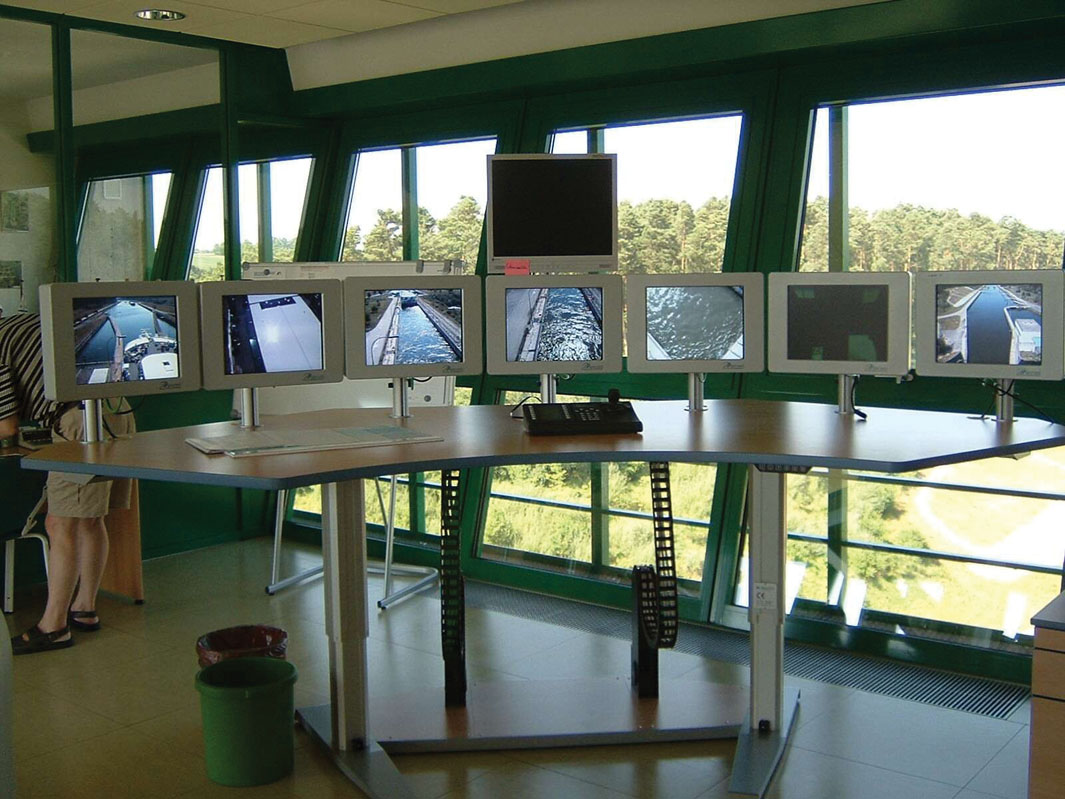
|
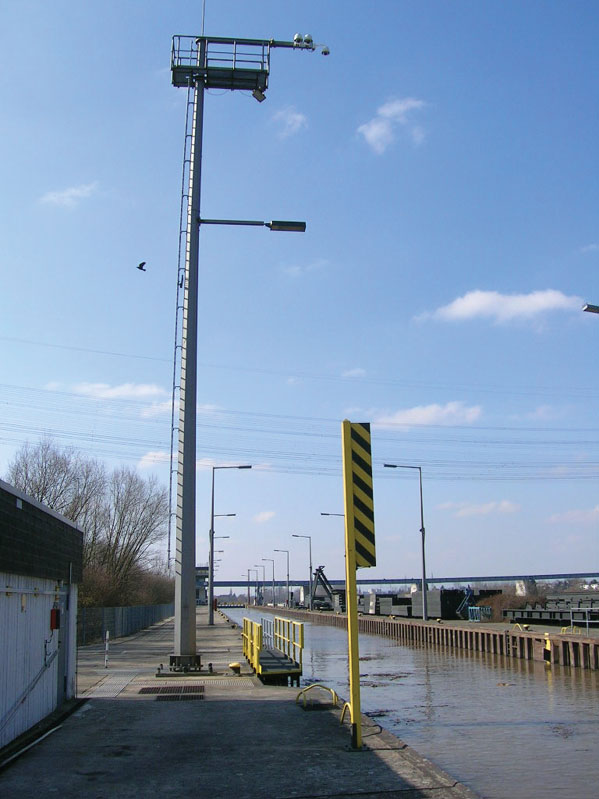
|
|
Photo by Bosch Security Systems |
|
CAMERA INSTALLATION & SET-UP
Easy installation and remote set-up of cameras is facilitated with Bosch¡¯s proprietary Bilinx Bi-Directional Communication Technology. Bilinx uses fiber optic or conventional CCTV coax or Unshielded Twisted Pair (UTP) video transmission links to provide two-way communication with a camera. Bilinx technology embeds control and configuration commands in the video signal, enabling any number of functions that otherwise would require direct camera access or separate wiring to be programmed over the video cable.
This is a major advantage in installations where cameras are difficult to reach, such as mounted high up on a mast, or where operation would be interrupted by a service call.
VIDEO RECORDING & CONTROL
CCTV surveillance of waterways and their locks is not just a matter of real-time monitoring. Recording of video images is necessary in the event of incidents, such as personal injury, damage to vessels or structures, incorrect opening or closing of lock gates, trespassing, vandalism, polluting (for example, fuel oil spillage), or dumping of garbage. Bosch provides a number of scalable solutions for video recording and archiving, based on its range of Digital Video Recorders (DVRs) or, in the case of an IP-based system, Network Video Recorders (NVRs).
Bosch¡¯s DiBos DVR, for example, employs MPEG-4 compression to provide superior images and make 1ty and scalability.
Other features include digital recording at up to 50/60 frames per second (fps) and simultaneous playback, authentication of images for legal evidence, and advanced search facilities with smart motion search for easy retrieval.
ADVANTAGES OF IP
Already being applied in major transportation projects, networked CCTV-based on IP technology is becoming the solution of choice for medium- to large-scale surveillance systems. The advantages of IP-based surveillance installations over conventional DVR CCTV systems include scalability -- cameras can be added in increments of one, compared to 16-camera/channel steps for DVR; frame rate -- any camera can be provided with any frame rate at any time; and storage capacity that can be easily increased by adding hard drives and PC servers.
Bosch¡¯s VIDOS is a video surveillance and alarm management software package for IP-network CCTV. Using intuitive sitemaps, VIDOS gives an operator full system control while providing an overview of the status of all components and situations. The system integrates cameras, monitors and other existing components, and can be extended with VIDOS networked video recorders (NVRs) for long-term recording.
COMMUNICATION
Equally important as visual monitoring is audio communication between the lockmaster, other staff and the skippers of commercial traffic and boat owners. There are three possibilities. One is to use a public address and voice alarm system, such as Bosch¡¯s Praesideo or Plena. Horn loudspeakers with microphones provide two-way communication with vessels within earshot. The second possibility is to use marine UHF radio, which mostly applies to communicating with the skippers of commercial vessels. A third alternative is mobile telephony that, of course, requires knowledge of numerous different telephone numbers for each and every lock. It should be noted that not all locks are manned some are controlled remotely and in groups of two or more.
CCTV surveillance is of great value to inland waterways for safe navigation of commercial and private traffic through lock systems. Given that both commercial and tourist traffic are increasing, plus numerous countries¡¯ plans to extend or renovate canal systems, there is much potential for new business.
For more information, please send your e-mails to swm@infothe.com.
¨Ï2007 www.SecurityWorldMag.com. All rights reserved.
|



